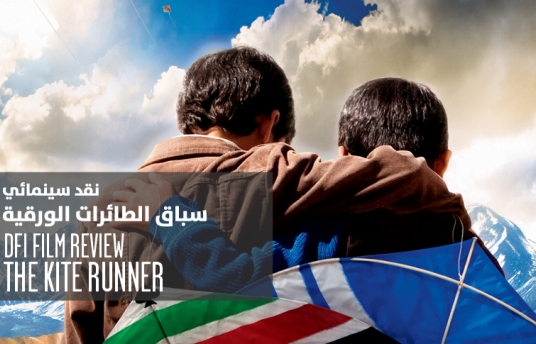نقد سينمائي: سباق الطائرات الورقية (2007)
18 سبتمبر 2011

بقلم ريم صالح، الاعلام الجديد، مؤسسة الدوحة للأفلام
فيلم: سباق الطائرات الورقية
إنتاج عام: 2007
إخراج: مارك فوستر
بطولة: خالد عبدالله، أحمد خان محمود زادا، أتوسا ليوني
النوع: دراما، عاطفي
تجري أحداث الفيلم الذي أخرجه مارك فوستر الذي اشتهر بإخراج فيلم “البحث عن نفرلاند“، في أفغانستان، وهو مقتبس عن رواية الكاتب خالد حسيني، التي تحمل العنوان ذاته. يروي الفيلم قصة طفليْن صديقيْن يعيشان في أفغانستان، في حقبة ما قبل الغزو الروسي. ترعرع كل من أمير (خالد عبدالله، وزكريا ابراهيمي)، ابن مفكر مناهض للروس، وحسن (أحمد خان محمود زادا) ابن خادم العائلة، معاً وتعلقا ببعضهما البعض بشكل كبير. جمعتهما متعة اللعب بالطائرات الورقية، كما كان حسن يحب أن يقرأ له أمير القصص، وهو أمر لم يكن قادراً عليه. غير أن أمير لم يعره اهتماماً حين واجه صعوبات وأدار له ظهره. يجبر الغزو الروسي أمير المُحمّل بأعباء الندم والشعور بالذنب إلى مغادرة البلد مع والده وبدء حياة جديدة. وبعد مرور الزمن تسنح له الفرصة لكي يتصالح مجدداً مع ماضيه.
تحلّق الطائرات الورقية في سماء أفغانستان الزرقاء، تدور وتجول في إطار مشهدية طبيعية خلابة مذهلة مليئة بالأمل والبراءة. في خضم هذه الأجواء الرائعة، ساد الاحترام والوفاء علاقة عائلتين تنتميين إلى مستويين اجتماعيين مختلفين.
كان والد أمير بابا دائم الانتقاد لابنه، وبحسب الوالد، فإن ابنه عاجز عن الدفاع عن نفسه.
في المقابل، كان حسن أوعى من أبناء جيله. تظهر عليه علامات الحكمة والموهبة الفطرية. لا يؤذي أحد ويدافع دوماً عن نفسه وعن أصدقائه.
“ثق بي“، يقول لأمير، “هل خيبت ظنك يوماً؟”.
بعد الفوز بمسابقة الطائرات الورقية، وهي رياضة شعبية في مدينتهما، يذهب حسن لجلب الطائرة الرابحة تاركاً أمير يستمتع بنشوة النصر. وفي طريقه يتعرض حسن لمضايقة مجموعة من الفتوات الذين يحاولون الحصول على طائرته، يرفض بشدّة لأنها تخصّ أمير صديقه الحميم. لا يتقبل الفتوات رفضه هذا، فيقومون بإهانته واغتصابه أمام أعين أمير الذي كان يراقب ما يجري عن بعد، وسرعان ما يغادر المكان بدل أن يهمّ بمساعدة صديقه. يشكّل شعور أمير بالذنب بداية انتهاء علاقتهما، وما يتبع هذه الحادثة يغيّر حياتهما للأبد. يبدأ أمير بتجنّب لقاء حسن، لأنها تتسبّب له بألم مبرح. يحاول جاهداً إقناع والده بتغيير الخدم، الأمر الذي يزعج والده جداً. إلاّ أن الاجتياح الروسي كان سبباً كافياً لكي تغادر العائلة الثرية البلد، تاركةً حسن ووالده خلفهما.
على الرغم من مرور سنوات، وتخرّجه من الجامعة في أميركا، إلاّ أن الذكرى المريرة لا تزال حاضرة بقوة في ذهن أمير. وإذ به يتلقى اتصالاً هاتفياً من بلده الأم يمنحه الفرصة لتصحيح ماضيه مع حسن، حتى لو تطلب الأمر المجازفة بحياته والعودة إلى بلده الذي تحكمه طالبان.
يرسم الفيلم ثلاث صور مختلفة لأفغانستان، الأولى هي مرحلة ما قبل الغزو الروسي المليئة بالطائرات الملونة وأجواء الحرية المفعمة بالبساطة والسعادة، حيث تبدو أفغانستان مكاناً جميلاً للعيش، تتجلى فيه المناقشات الأدبية والسياسية على طاولات المثقفين. نقلت المشاهد إلينا الأجواء المليئة بالحياة والألوان، والمعجنات والبهارات الأفغانية التي تكاد تلتقط عبقها حواسنا، عبر الشاشة. في هذه المرحلة، لا شيء سوى البساطة والمرح والثقافة والفن.
تنتقل هذه الصورة المفعمة بألوان الحياة إلى أخرى رمادية جرّاء الغزو الروسي، فيطبع خبو الألوان صورة البلد والصداقة والأمل. تسوء الأمور، تتغير كل المعالم والألوان التي عهدناها في السابق.
في الولايات المتحدة الأميركية، يلقي الفيلم الضوء على كفاح الأب وابنه أمير المهاجران من أجل لقمة العيش، على عكس ما كان الوضع عليه في بلدهما.
حين يقرّر أمير العودة إلى أفغانستان، يواجهه نوعاً آخر من المخاطر، وهي الصورة الثالثة لأفغانستان التي يحكمها المسلمون الأصوليون. وضعت حركة طالبان قوانين جديدة ومنعت كل شيء ممتع وجميل بما في ذلك اللعب بالطائرات الورقية. يبدو صدى الشوارع مختلفاً، والموت يخيّم على كل زاوية، حتى أن الناس جميعهم فقدوا الابتسامة.
يرسم الفيلم صورة حيّة واقعية لأفغانستان، عجز الإعلام عن إيصالها لنا ، إلاّ أن حنين الماضي يذكرنا بالتاريخ الحديث لأفغانستان في السابق والتي نسيها الكثيرون.
تميّز أداء الأطفال بقوة التأثير والعفوية المطلقة، ما يذكرنا بأعمال المخرجين الإيرانيين عباس كياروستامي وجعفر باناهي، اللذين نجحا في التعامل مع الأطفال واستخراج أفضل الأداء منهم.
من ناحية المضمون السياسي، تلمح القصة إلى سقوط أحلام هذا البلد مع توقف الطائرات الورقية عن الطيران، فضلاً عن ولاء الناس المزيف والقصري لطالبان.
في سياق قصة الصداقة الاستثنائية هذه، يبدو أن الزمن كان قادراً على خلق فرصة نادرة للوصول إلى نهاية سعيدة.
فالأمل لا يغيب طالما أن هناك طائرات ورقية تحلق.
The Kite Runner - Trailer
إعلان فيلم سباق الطائرات الورقية